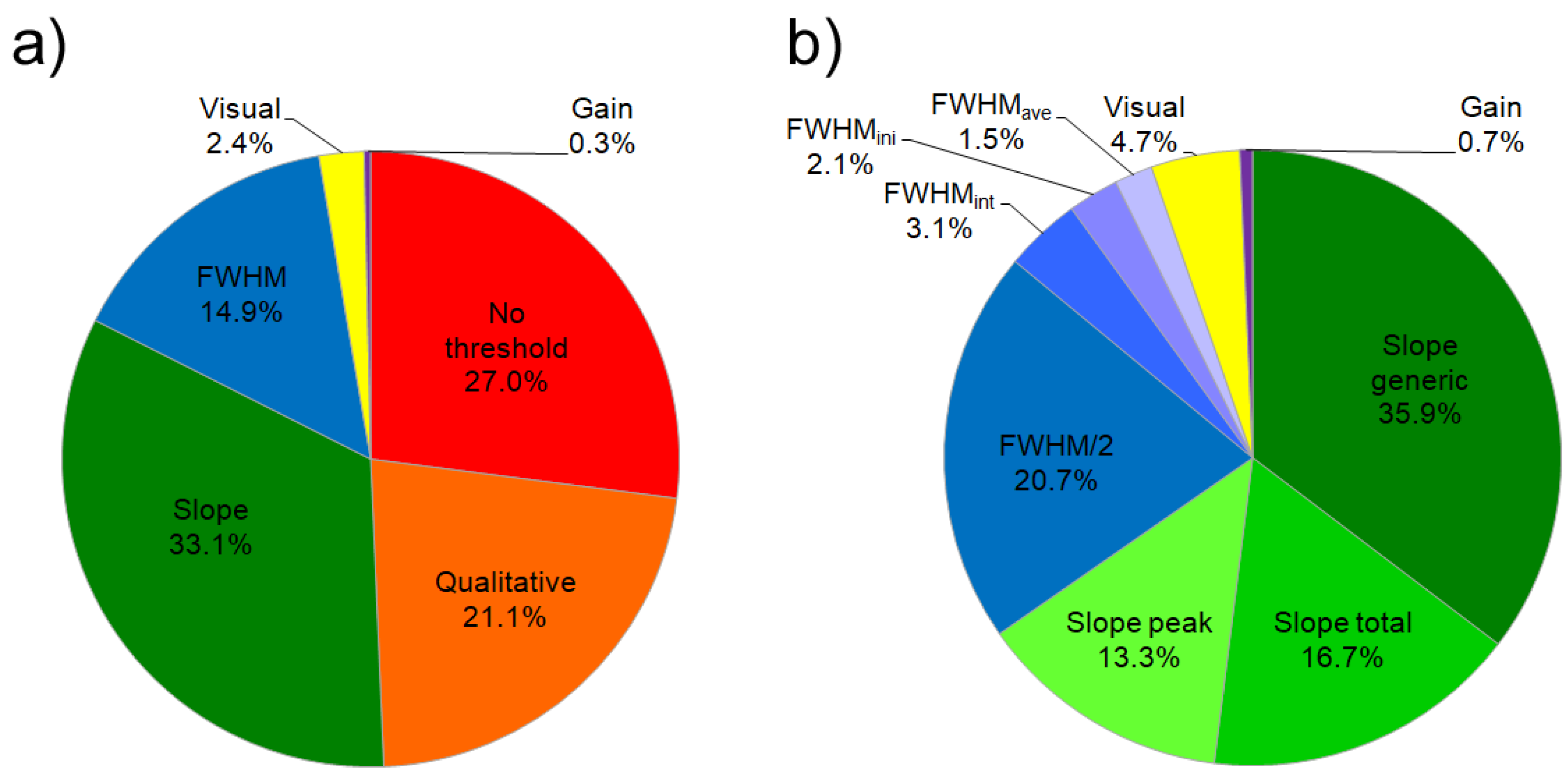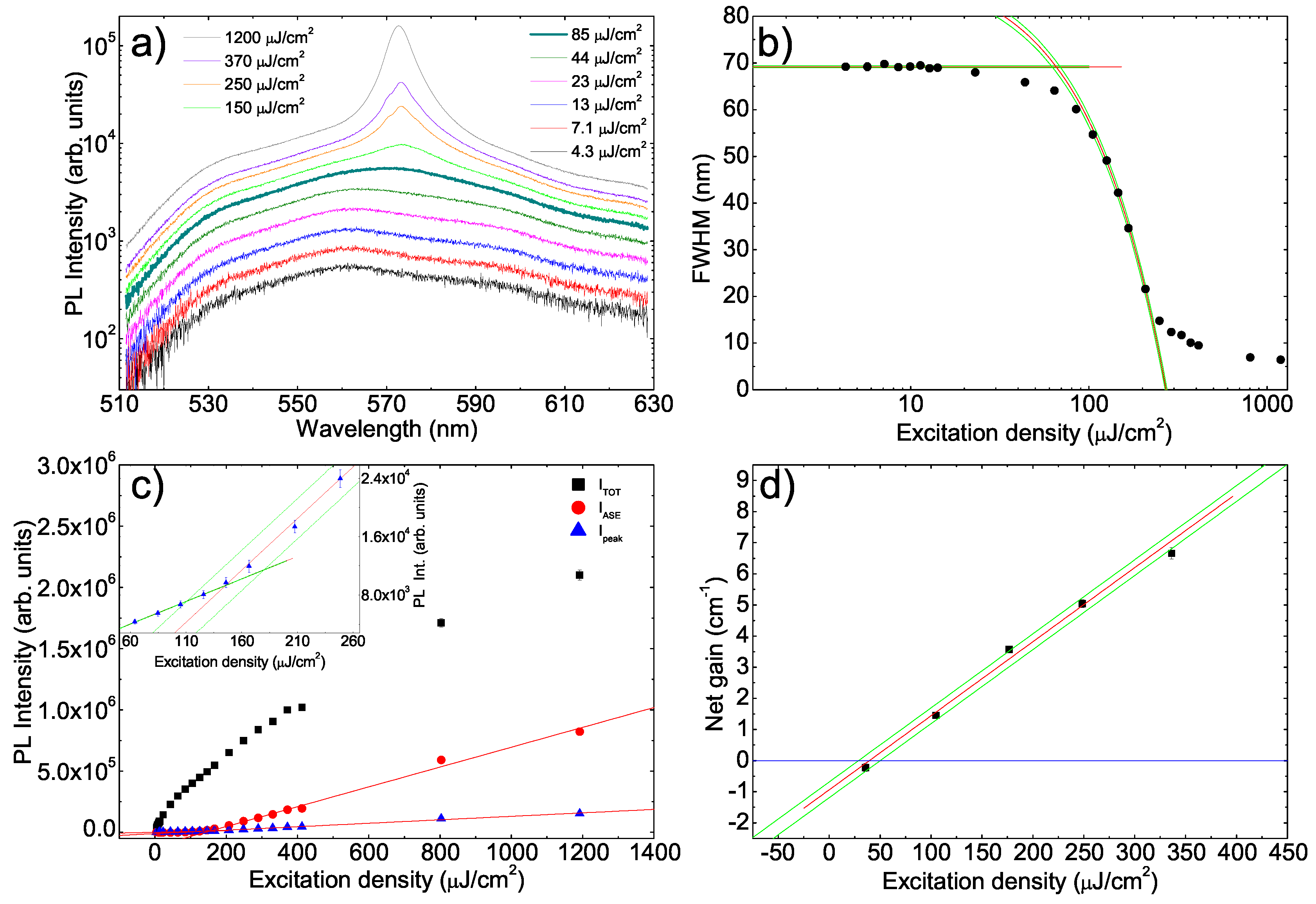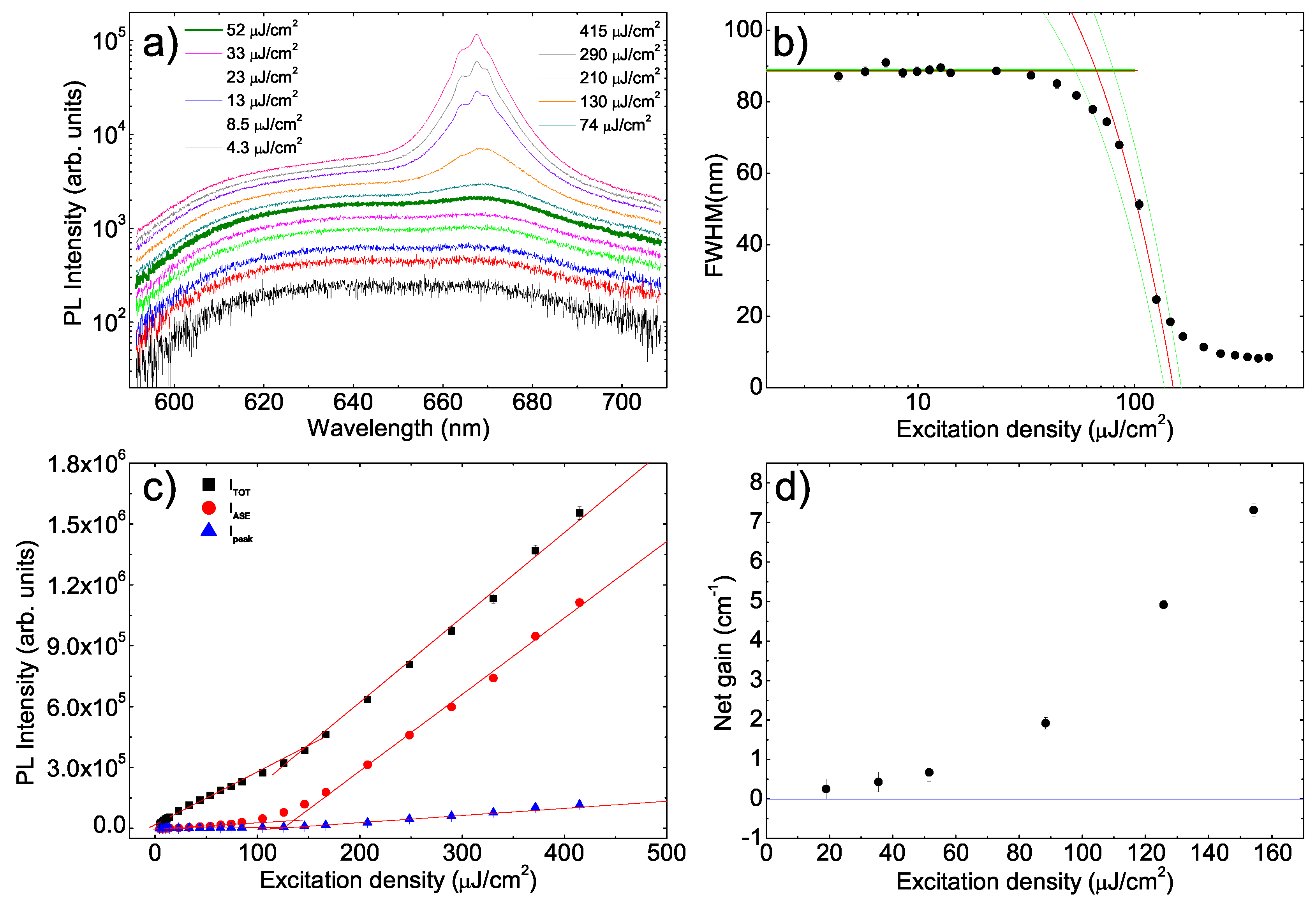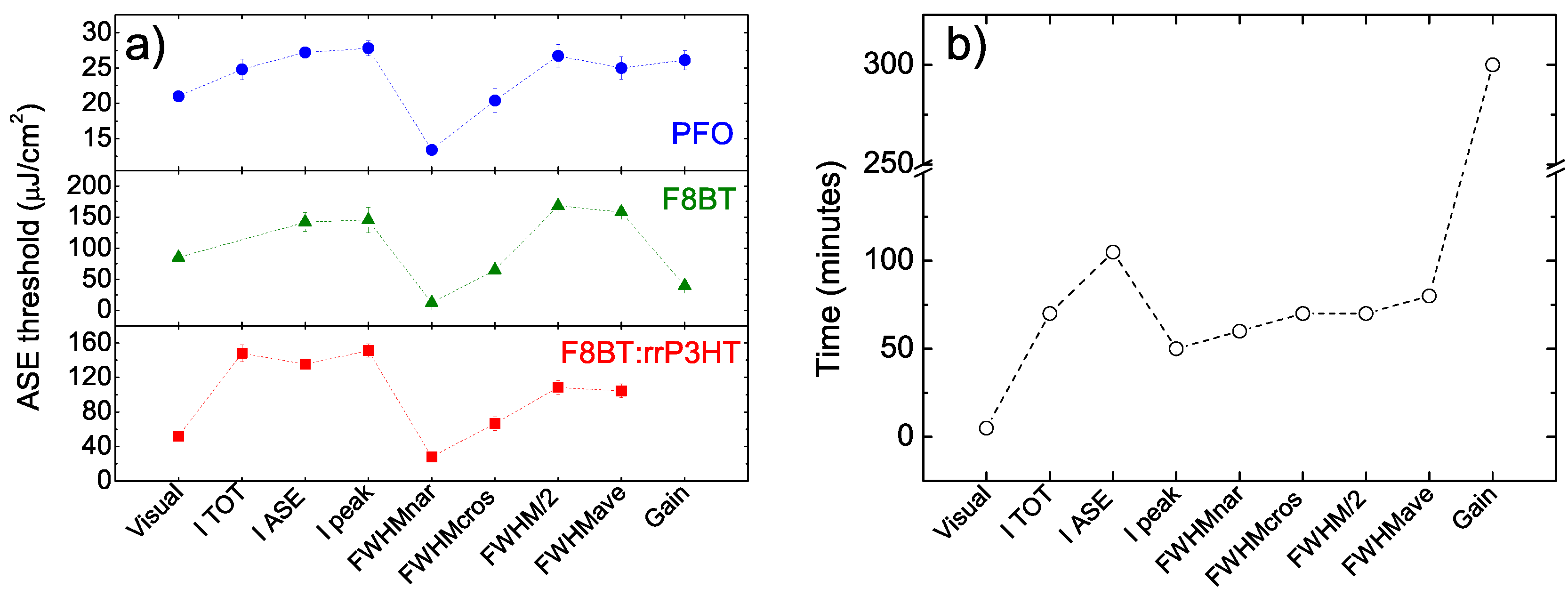Determination of the Best Empiric Method to Quantify the Amplified Spontaneous Emission Threshold in Polymeric Active Waveguides
Abstract
1. Introduction
2. Results
- the linewidth reaches one half of its constant value at low excitation density ();
- the linewidth reaches the average value between the high one at low excitation density and the low one at high excitation density ();
- the linewidth starts to decrease ();
- the extrapolations of the two best fit lines cross ().
3. Discussion
4. Materials and Methods
4.1. Sample Preparation
4.2. VPI and VSL Measurements
4.3. Thickness Measurements
5. Conclusions
Supplementary Materials
Author Contributions
Funding
Conflicts of Interest
References
- Moses, D. High Quantum Efficiency Luminescence from a Conducting Polymer in Solution: A Novel Polymer Laser Dye. Appl. Phys. Lett. 1992, 60, 3215–3216. [Google Scholar] [CrossRef]
- Hide, F.; Diaz-García, M.A.; Schwartz, B.J.; Andersson, M.R.; Pei, Q.; Heeger, A.J. Semiconducting Polymers: A New Class of Solid-State Laser Materials. Science 1996, 273, 1833–1836. [Google Scholar] [CrossRef]
- Friend, R.H.; Gymer, R.W.; Holmes, A.B.; Burroughes, J.H.; Marks, R.N.; Taliani, C.; Bradley, D.D.C.; Dos Santos, D.A.; Brédas, J.L.; Lögdlund, M.; et al. Electroluminescence in Conjugated Polymers. Nature 1999, 397, 121–128. [Google Scholar] [CrossRef]
- Frolov, S.V.; Gellermann, W.; Ozaki, M.; Yoshino, K.; Vardeny, Z.V. Cooperative Emission in π-Conjugated Polymer Thin Films. Phys. Rev. Lett. 1997, 78, 729–732. [Google Scholar] [CrossRef]
- Tessler, N. Lasers Based on Semiconducting Organic Materials. Adv. Mater. 1999, 11, 363–370. [Google Scholar] [CrossRef]
- Scherf, U.; Riechel, S.; Lemmer, U.; Mahrt, R. Conjugated Polymers: Lasing and Stimulated Emission. Curr. Opin. Solid State Mater. Sci. 2001, 5, 143–154. [Google Scholar] [CrossRef]
- McGehee, M.D.; Heeger, A.J. Semiconducting (Conjugated) Polymers as Materials for Solid-State Lasers. Adv. Mater. 2000, 12, 1655–1668. [Google Scholar] [CrossRef]
- Holzer, W.; Penzkofer, A.; Gong, S.H.; Blau, W.J.; Davey, A.P. Effective Stimulated Emission and Excited-State Absorption Cross-Section Spectra of Para-phenylene-ethynylene Polymers. Opt. Quantum Electron. 1998, 30, 1–14. [Google Scholar] [CrossRef]
- Frolov, S.V.; Fujii, A.; Chinn, D.; Vardeny, Z.V.; Yoshino, K.; Gregory, R.V. Cylindrical Microlasers and Light Emitting Devices from Conducting Polymers. Appl. Phys. Lett. 1998, 72, 2811–2813. [Google Scholar] [CrossRef]
- Tessler, N.; Denton, G.J.; Friend, R.H. Lasing from Conjugated Polymer Microcavities. Nature 1996, 382, 695–697. [Google Scholar] [CrossRef]
- McGehee, M.D.; Diaz-García, M.A.; Hide, F.; Gupta, R.; Miller, E.K.; Moses, D.; Heeger, A.J. Semiconducting Polymer Distributed Feedback Lasers. Appl. Phys. Lett. 1998, 72, 1536–1538. [Google Scholar] [CrossRef]
- Xia, R.; Heliotis, G.; Hou, Y.; Bradley, D.D.C. Fluorene-Based Conjugated Polymer Optical Gain Media. Org. Electron. 2003, 4, 165–177. [Google Scholar] [CrossRef]
- Chua, L.L.; Ho, P.K.H.; Sirringhaus, H.; Friend, R.H. Observation of Field-Effect Transistor Behavior at Self-Organized Interfaces. Adv. Mater. 2004, 16, 1609–1615. [Google Scholar] [CrossRef]
- Kim, D.H.; Han, J.T.; Park, Y.D.; Jang, Y.; Cho, J.H.; Hwang, M.; Cho, K. Single-Crystal Polythiophene Microwires Grown by Self-Assembly. Adv. Mater. 2006, 18, 719–723. [Google Scholar] [CrossRef]
- Minemawari, H.; Yamada, T.; Matsui, H.; Tsutsumi, J.; Haas, S.; Chiba, R.; Kumai, R.; Hasegawa, T. Inkjet Printing of Single-Crystal Films. Nature 2011, 475, 364–367. [Google Scholar] [CrossRef]
- Arias, A.C.; Ready, S.E.; Lujan, R.; Wong, W.S.; Paul, K.E.; Salleo, A.; Chabinyc, M.L.; Apte, R.; Street, R.A.; Wu, Y.; et al. All Jet-Printed Polymer Thin-Film Transistor Active-Matrix Backplanes. Appl. Phys. Lett. 2004, 85, 3304–3306. [Google Scholar] [CrossRef]
- Rogowski, R.Z.; Dzwilewski, A.; Kemerink, M.; Darhuber, A.A. Solution Processing of Semiconducting Organic Molecules for Tailored Charge Transport Properties. J. Phys. Chem. C 2011, 115, 11758–11762. [Google Scholar] [CrossRef]
- Becerril, H.A.; Roberts, M.E.; Liu, Z.; Locklin, J.; Bao, Z. High-Performance Organic Thin-Film Transistors through Solution-Sheared Deposition of Small-Molecule Organic Semiconductors. Adv. Mater. 2008, 20, 2588–2594. [Google Scholar] [CrossRef]
- Wu, D.; Kaplan, M.; Ro, H.W.; Engmann, S.; Fischer, D.A.; De Longchamp, D.M.; Richter, L.J.; Gann, E.; Thomsen, L.; McNeill, C.R.; et al. Blade Coating Aligned, High-Performance, Semiconducting-Polymer Transistors. Chem. Mater. 2018, 30, 1924–1936. [Google Scholar] [CrossRef]
- Anni, M.; Lattante, S. (Eds.) Organic Lasers: Fundamentals, Developments and Applications; Pan Stanford Publishing: Singapore, 2018. [Google Scholar]
- Kuehne, A.J.C.; Gather, M.C. Organic Lasers: Recent Developments on Materials, Device Geometries, and Fabrication Techniques. Chem. Rev. 2016, 116, 12823–12864. [Google Scholar] [CrossRef]
- Sandanayaka, A.S.D.; Matsushima, T.; Bencheikh, F.; Terakawa, S.; Potscavage, W.J.; Qin, C.; Fujihara, T.; Goushi, K.; Ribierre, J.C.; Adachi, C. Indication of current-injection lasing from an organic semiconductor. Appl. Phys. Express 2019, 12, 061010. [Google Scholar] [CrossRef]
- McGehee, M.D.; Gupta, R.; Veenstra, S.; Miller, E.K.; Díaz-García, M.A.; Heeger, A.J. Amplified spontaneous emission from photopumped films of a conjugated polymer. Phys. Rev. B 1998, 58, 7035–7039. [Google Scholar] [CrossRef]
- Laquai, F.; Keivanidis, P.E.; Baluschev, S.; Jacob, J.; Müllen, K.; Wegner, G. Low-Threshold Amplified Spontaneous Emission in thin Films of Poly(tetraarylindenofluorene). Appl. Phys. Lett. 2005, 87, 261917. [Google Scholar] [CrossRef]
- Park, J.Y.; Srdanov, V.I.; Heeger, A.J.; Lee, C.H.; Park, Y.W. Amplified Spontaneous Emission from an MEH-PPV Film in Cylindrical Geometry. Synth. Met. 1999, 106, 35–38. [Google Scholar] [CrossRef]
- Lee, T.W.; Park, O.O.; Choi, D.H.; Cho, H.N.; Kim, Y.C. Low-threshold blue amplified spontaneous emission in a statistical copolymer and its blend. Appl. Phys. Lett. 2002, 81, 424–426. [Google Scholar] [CrossRef]
- Heliotis, G.; Xia, R.; Bradley, D.D.C.; Turnbull, G.A.; Samuel, I.D.W.; Andrew, P.; Barnes, W.L. Blue, Surface-Emitting, Distributed Feedback Polyfluorene Lasers. Appl. Phys. Lett. 2003, 83, 2118–2120. [Google Scholar] [CrossRef]
- Chen, Y.; Herrnsdorf, J.; Guilhabert, B.; Kanibolotsky, A.L.; Mackintosh, A.R.; Wang, Y.; Pethrick, R.A.; Gu, E.; Turnbull, G.A.; Skabara, P.J.; et al. Laser action in a surface-structured free-standing membrane based on a π-conjugated polymer-composite. Org. Electron. 2011, 12, 62–69. [Google Scholar] [CrossRef]
- Foucher, C.; Guilhabert, B.; Kanibolotsky, A.L.; Skabara, P.J.; Laurand, N.; Dawson, M.D. RGB and White-Emitting Organic Lasers on Flexible Glass. Opt. Express 2016, 24, 2273–2280. [Google Scholar] [CrossRef]
- Pan, J.Q.; Yi, J.P.; Xie, G.; Lai, W.Y.; Huang, W. Enhancing Optical Gain Stability for a Deep-Blue Emitter Enabled by a Low-Loss Transparent Matrix. J. Phys. Chem. C 2018, 122, 21569–21578. [Google Scholar] [CrossRef]
- Kim, D.H.; Sandanayaka, A.S.D.; Zhao, L.; Pitrat, D.; Mulatier, J.C.; Matsushima, T.; Andraud, C.; Ribierre, J.C.; Adachi, C. Extremely low amplified spontaneous emission threshold and blue electroluminescence from a spin-coated octafluorene neat film. Appl. Phys. Lett. 2017, 110, 023303. [Google Scholar] [CrossRef]
- Mai, V.T.; Shukla, A.; Mamada, M.; Maedera, S.; Shaw, P.E.; Sobus, J.; Allison, I.; Adachi, C.; Namdas, E.B.; Lo, S.C. Low Amplified Spontaneous Emission Threshold and Efficient Electroluminescence from a Carbazole Derivatized Excited-State Intramolecular Proton Transfer Dye. ACS Photonics 2018, 5, 4447–4455. [Google Scholar] [CrossRef]
- Holzer, W.; Penzkofer, A.; Schmitt, T.; Hartmann, A.; Bader, C.; Tillmann, H.; Raabe, D.; Stockmann, R.; Hörhold, H.H. Amplified spontaneous emission in neat films of arylene-vinylene polymers. Opt. Quantum Electron. 2001, 33, 121–150. [Google Scholar] [CrossRef]
- Xia, R.; Lai, W.Y.; Levermore, P.A.; Huang, W.; Bradley, D.D.C. Low-Threshold Distributed-Feedback Lasers Based on Pyrene-Cored Starburst Molecules with 1,3,6,8-Attached Oligo(9,9-Dialkylfluorene) Arms. Adv. Funct. Mater. 2009, 19, 2844–2850. [Google Scholar] [CrossRef]
- Lampert, Z.E.; Lappi, S.E.; Papanikolas, J.M.; Lewis Reynolds, C. Intrinsic optical gain in thin films of a conjugated polymer under picosecond excitation. Appl. Phys. Lett. 2013, 103, 033303. [Google Scholar] [CrossRef]
- Anni, M.; Lattante, S. Amplified Spontaneous Emission Optimization in Regioregular Poly(3-hexylthiophene) (rrP3HT): Poly(9,9-dioctylfluorene-cobenzothiadiazole) (F8BT) Thin Films through Control of the Morphology. J. Phys. Chem. C 2015, 119, 21620–21625. [Google Scholar] [CrossRef]
- Lampert, Z.E.; Papanikolas, J.M.; Lappi, S.E.; Reynolds, C.L. Intrinsic gain and gain degradation modulated by excitation pulse width in a semiconducting conjugated polymer. Opt. Laser Technol. 2017, 94, 77–85. [Google Scholar] [CrossRef]
- Xia, R.; Stavrinou, P.N.; Bradley, D.D.C.; Kim, Y. Efficient Optical Gain Media Comprising Binary Blends of Poly(3-hexylthiophene) and Poly(9,9-dioctylfluorene-co-benzothiadiazole). J. Appl. Phys. 2012, 111, 123107. [Google Scholar] [CrossRef]
- Schweitzer, B.; Wegmann, G.; Giessen, H.; Hertel, D.; Bässler, H.; Mahrt, R.F.; Scherf, U.; Müllen, K. The optical gain mechanism in solid conjugated polymers. Appl. Phys. Lett. 1998, 72, 2933–2935. [Google Scholar] [CrossRef]
- Wegmann, G.; Schweitzer, B.; Hertel, D.; Giessen, H.; Oestreich, M.; Scherf, U.; Müllen, K.; Mahrt, R. The dynamics of gain-narrowing in a ladder-type π-conjugated polymer. Chem. Phys. Lett. 1999, 312, 376–384. [Google Scholar] [CrossRef]
- Heliotis, G.; Bradley, D.D.C. Light Amplification and Gain in Polyfluorene Waveguides. Appl. Phys. Lett. 2002, 81, 415–417. [Google Scholar] [CrossRef]
- Gupta, R.; Stevenson, M.; Heeger, A.J. Low Threshold Distributed Feedback Lasers Fabricated from Blends of Conjugated Polymers: Reduced Losses through Förster Transfer. J. Appl. Phys. 2002, 92, 4874–4877. [Google Scholar] [CrossRef]
- Azuma, H.; Kobayashi, T.; Shim, Y.; Mamedov, N.; Naito, H. Amplified spontaneous emission in α-phase and β-phase polyfluorene waveguides. Org. Electron. 2007, 8, 184–188. [Google Scholar] [CrossRef]
- Kim, Y.C.; Lee, T.W.; Park, O.O.; Kim, C.Y.; Cho, H.N. Low-Threshold Amplified Spontaneous Emission in a Fluorene-Based Liquid Crystalline Polymer Blend. Adv. Mater. 2001, 13, 646–649. [Google Scholar] [CrossRef]
- Lattante, S.; Cretí, A.; Lomascolo, M.; Anni, M. On the Correlation between Morphology and Amplified Spontaneous Emission Properties of a Polymer: Polymer Blend. Org. Electron. 2016, 29, 44–49. [Google Scholar] [CrossRef]
- Li, J.Y.; Laquai, F.; Wegner, G. Amplified spontaneous emission in optically pumped neat films of a polyfluorene derivative. Chem. Phys. Lett. 2009, 478, 37–41. [Google Scholar] [CrossRef]
- Abdel-Awwad, M.; Luan, H.; Messow, F.; Kusserow, T.; Wiske, A.; Siebert, A.; Fuhrmann-Lieker, T.; Salbeck, J.; Hillmer, H. Optical amplification and photodegradation in films of spiro-quaterphenyl and its derivatives. J. Lumin. 2015, 159, 47–54. [Google Scholar] [CrossRef]
- Brouwer, H.J.; Krasnikov, V.V.; Pham, T.A.; Gill, R.E.; Hadziioannou, G. Stimulated emission from vacuum-deposited thin films of a substituted oligo(p-phenylene vinylene). Appl. Phys. Lett. 1998, 73, 708–710. [Google Scholar] [CrossRef]
- Anni, M.; Alemanno, M. Temperature dependence of the amplified spontaneous emission of the poly(9,9-dioctylfluorene) β phase. Phys. Rev. B 2008, 78, 233102. [Google Scholar] [CrossRef]
- Anni, M.; Perulli, A.; Monti, G. Thickness Dependence of the Amplified Spontaneous Emission Threshold and Operational Stability in poly(9,9-dioctylfluorene) Active Waveguides. J. Appl. Phys. 2012, 111, 093109. [Google Scholar] [CrossRef]
- Anni, M. Operational lifetime improvement of poly(9,9-dioctylfluorene) active waveguides by thermal lamination. Appl. Phys. Lett. 2012, 101, 013303. [Google Scholar] [CrossRef]
- Chang, S.J.; Liu, X.; Lu, T.T.; Liu, Y.Y.; Pan, J.Q.; Jiang, Y.; Chu, S.Q.; Lai, W.Y.; Huang, W. Ladder-type poly(indenofluorene-co-benzothiadiazole)s as efficient gain media for organic lasers: Design, synthesis, optical gain properties, and stabilized lasing properties. J. Mater. Chem. C 2017, 5, 6629–6639. [Google Scholar] [CrossRef]
- Lattante, S.; De Giorgi, M.L.; Pasini, M.; Anni, M. Low threshold Amplified Spontaneous Emission properties in deep blue of poly[(9,9-dioctylfluorene-2,7-dyil)-alt-p-phenylene] thin films. Opt. Mater. 2017, 72, 765–768. [Google Scholar] [CrossRef]
- Zhang, Q.; Liu, J.; Wei, Q.; Guo, X.; Xu, Y.; Xia, R.; Xie, L.; Qian, Y.; Sun, C.; Lüer, L.; et al. Host Exciton Confinement for Enhanced Förster-Transfer-Blend Gain Media Yielding Highly Efficient Yellow-Green Lasers. Adv. Funct. Mater. 2018, 28, 1705824. [Google Scholar] [CrossRef]
- Anni, M. Dual band amplified spontaneous emission in the blue in Poly(9,9-dioctylfluorene) thin films with phase separated glassy and β-phases. Opt. Mater. 2019, 96, 109313. [Google Scholar] [CrossRef]
- Anni, M. Poly[2-methoxy-5-(2-ethylhexyloxy)-1,4-phenylenevinylene] (MeH-PPV) Amplified Spontaneous Emission Optimization in Poly(9,9-dioctylfluorene(PFO):MeH-PPV Active Blends. J. Lumin. 2019, 215, 116680. [Google Scholar] [CrossRef]
- Virgili, T.; Anni, M.; De Giorgi, M.L.; Borrego Varillas, R.; Squeo, B.M.; Pasini, M. Deep Blue Light Amplification from a Novel Triphenylamine Functionalized Fluorene Thin Film. Molecules 2019, 25, 79. [Google Scholar] [CrossRef]
- Anni, M. Photodegradation Effects on the Emission Properties of an Amplifying Poly(9,9- dioctylfluorene) Active Waveguide Operating in Air. J. Phys. Chem. B 2012, 116, 4655–4660. [Google Scholar] [CrossRef]
- Sznitko, L.; Mysliwiec, J.; Miniewicz, A. The Role of Polymers in Random Lasing. J. Polym. Sci. Part B Polym. Phys. 2015, 53, 951–974. [Google Scholar] [CrossRef]
- Anni, M.; Rhee, D.; Lee, W.K. Random Lasing Engineering in Poly-(9-9dioctylfluorene) Active Waveguides Deposited on Wrinkles Corrugated Surfaces. ACS Appl. Mater. Int. 2019, 11, 9385–9393. [Google Scholar] [CrossRef]
- Frolov, S.V.; Vardeny, Z.V.; Yoshino, K.; Zakhidov, A.; Baughman, R.H. Stimulated emission in high-gain organic media. Phys. Rev. B 1999, 59, R5284–R5287. [Google Scholar] [CrossRef]
- Anni, M.; Lattante, S.; Cingolani, R.; Gigli, G.; Barbarella, G.; Favaretto, L. Far-field emission and feedback origin of random lasing in oligothiophene dioxide neat films. Appl. Phys. Lett. 2003, 83, 2754–2756. [Google Scholar] [CrossRef]
- Anni, M. The role of the β-phase content on the stimulated emission of poly(9,9-dioctylfluorene) thin films. Appl. Phys. Lett. 2008, 93, 023308. [Google Scholar] [CrossRef]
- Yamashita, K.; Kuro, T.; Oe, K.; Yanagi, H. Low Threshold Amplified Spontaneous Emission from Near-Infrared Dye-Doped Polymeric Waveguide. Appl. Phys. Lett. 2006, 88, 241110. [Google Scholar] [CrossRef]
- Navarro-Fuster, V.; Calzado, E.M.; Ramirez, M.G.; Boj, P.G.; Henssler, J.T.; Matzger, A.J.; Hernandez, V.; Lopez Navarrete, J.T.; Diaz-Garcia, M.A. Effect of ring fusion on the amplified spontaneous emission properties of oligothiophenes. J. Mater. Chem. 2009, 19, 6556–6567. [Google Scholar] [CrossRef]
- Kazlauskas, K.; Kreiza, G.; Bobrovas, O.; Adomeniene, O.; Adomenas, P.; Jankauskas, V.; Jursenas, S. Fluorene- and benzofluorene-cored oligomers as low threshold and high gain amplifying media. Appl. Phys. Lett. 2015, 107, 043301. [Google Scholar] [CrossRef]
- Lahoz, F.; Oton, C.J.; Capuj, N.; Ferrer-González, M.; Cheylan, S.; Navarro-Urrios, D. Reduction of the amplified spontaneous emission threshold in semiconducting polymer waveguides on porous silica. Opt. Express 2009, 17, 16766–16775. [Google Scholar] [CrossRef]
- Navarro-Fuster, V.; Calzado, E.M.; Boj, P.G.; Quintana, J.A.; Villalvilla, J.M.; Diaz-Garcia, M.A.; Trabadelo, V.; Juarros, A.; Retolaza, A.; Merino, S. Highly photostable organic distributed feedback laser emitting at 573 nm. Appl. Phys. Lett. 2010, 97, 171104. [Google Scholar] [CrossRef]
- Calzado, E.M.; Villalvilla, J.M.; Boj, P.G.; Quintana, J.A.; Diaz-Garcia, M.A. Tuneability of amplified spontaneous emission through control of the thickness in organic-based waveguides. J. Appl. Phys 2005, 97, 093103. [Google Scholar] [CrossRef]
- Liu, J.; Qian, Y.; Wei, Q.; Zhang, Q.; Xie, L.; Lee, C.; Kim, H.; Kim, Y.; Xia, R. Deep Blue Laser Gain Medium Based on Triphenylamine Substituted Arylfluorene With Improved Photo-Stability. IEEE J. Sel. Top. Quantum Electron. 2016, 22, 15–20. [Google Scholar] [CrossRef]
- Munoz-Marmol, R.; Zink-Lorre, N.; Villalvilla, J.M.; Boj, P.G.; Quintana, J.A.; Vaszquez, C.; Anderson, A.; Gordon, M.J.; Sastre-Santos, A.; Fernandez-Lazaro, F.; et al. Influence of Blending Ratio and Polymer Matrix on the Lasing Properties of Perylenediimide Dyes. J. Phys. Chem. C 2018, 122, 24896–24906. [Google Scholar] [CrossRef]
- Calzado, E.M.; Villalvilla, J.M.; Boj, P.G.; Quintana, J.A.; Gomez, R.; Segura, J.L.; Diaz-Garcia, M.A. Effect of Structural Modifications in the Spectral and Laser Properties of Perylenediimide Derivatives. J. Phys. Chem. C 2007, 111, 13595. [Google Scholar] [CrossRef]
- Cerdán, L.; Costela, A.; García-Moreno, I.; García, O.; Sastre, R. Waveguides and Quasi-Waveguides based on Pyrromethene 597-Doped Poly(methyl methacrylate). Appl. Phys. B 2009, 97, 73–83. [Google Scholar] [CrossRef]
- Kumar, G.A.; Riman, R.E.; Banerjee, S.; Kornienko, A.; Brennan, J.G.; Chen, S.; Smith, D.; Ballato, J. Infrared fluorescence and optical gain characteristics of chalcogenide-bound erbium cluster-fluoropolymer nanocomposites. Appl. Phys. Lett. 2006, 88, 091902. [Google Scholar] [CrossRef]
- Pisignano, D.; Anni, M.; Gigli, G.; Cingolani, R.; Zavelani-Rossi, M.; Lanzani, G.; Barbarella, G.; Favaretto, L. Amplified spontaneous emission and efficient tunable laser emission from a substituted thiophene-based oligomer. Appl. Phys. Lett. 2002, 81, 3534–3536. [Google Scholar] [CrossRef]
- Ryu, G.; Xia, R.; Bradley, D.D.C. Optical gain characteristics of β-phase poly(9,9-dioctylfluorene). J. Phys. Condens. Matter 2007, 19, 056205. [Google Scholar] [CrossRef]
- Conwell, E.M. Organic Electronic Materials; Springer: Berlin/Heidelberg, Germany, 2001; pp. 170–174. [Google Scholar]
- Dal Negro, L.; Bettotti, P.; Cazzanelli, M.; Pacifici, D.; Pavesi, L. Applicability Conditions and Experimental Analysis of the Variable Stripe Length Method for Gain Measurements. Opt. Commun. 2004, 229, 337–348. [Google Scholar] [CrossRef]





| Method | ASE Threshold () | ||
|---|---|---|---|
| PFO | F8BT | F8BT:rrP3HT | |
| Visual | ∼21 | ∼85 | ∼52 |
| N/A | |||
| Gain | N/A | ||
© 2020 by the authors. Licensee MDPI, Basel, Switzerland. This article is an open access article distributed under the terms and conditions of the Creative Commons Attribution (CC BY) license (http://creativecommons.org/licenses/by/4.0/).
Share and Cite
Milanese, S.; De Giorgi, M.L.; Anni, M. Determination of the Best Empiric Method to Quantify the Amplified Spontaneous Emission Threshold in Polymeric Active Waveguides. Molecules 2020, 25, 2992. https://doi.org/10.3390/molecules25132992
Milanese S, De Giorgi ML, Anni M. Determination of the Best Empiric Method to Quantify the Amplified Spontaneous Emission Threshold in Polymeric Active Waveguides. Molecules. 2020; 25(13):2992. https://doi.org/10.3390/molecules25132992
Chicago/Turabian StyleMilanese, Stefania, Maria Luisa De Giorgi, and Marco Anni. 2020. "Determination of the Best Empiric Method to Quantify the Amplified Spontaneous Emission Threshold in Polymeric Active Waveguides" Molecules 25, no. 13: 2992. https://doi.org/10.3390/molecules25132992
APA StyleMilanese, S., De Giorgi, M. L., & Anni, M. (2020). Determination of the Best Empiric Method to Quantify the Amplified Spontaneous Emission Threshold in Polymeric Active Waveguides. Molecules, 25(13), 2992. https://doi.org/10.3390/molecules25132992







